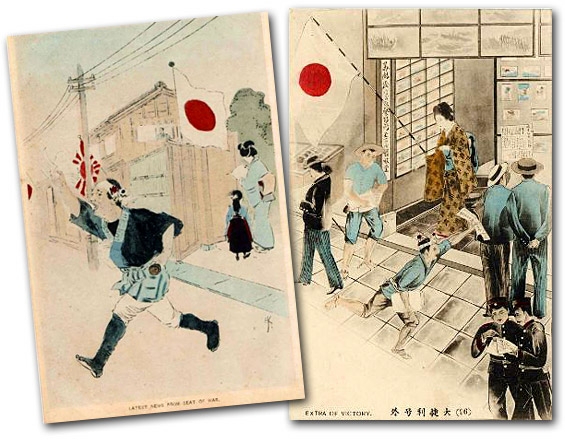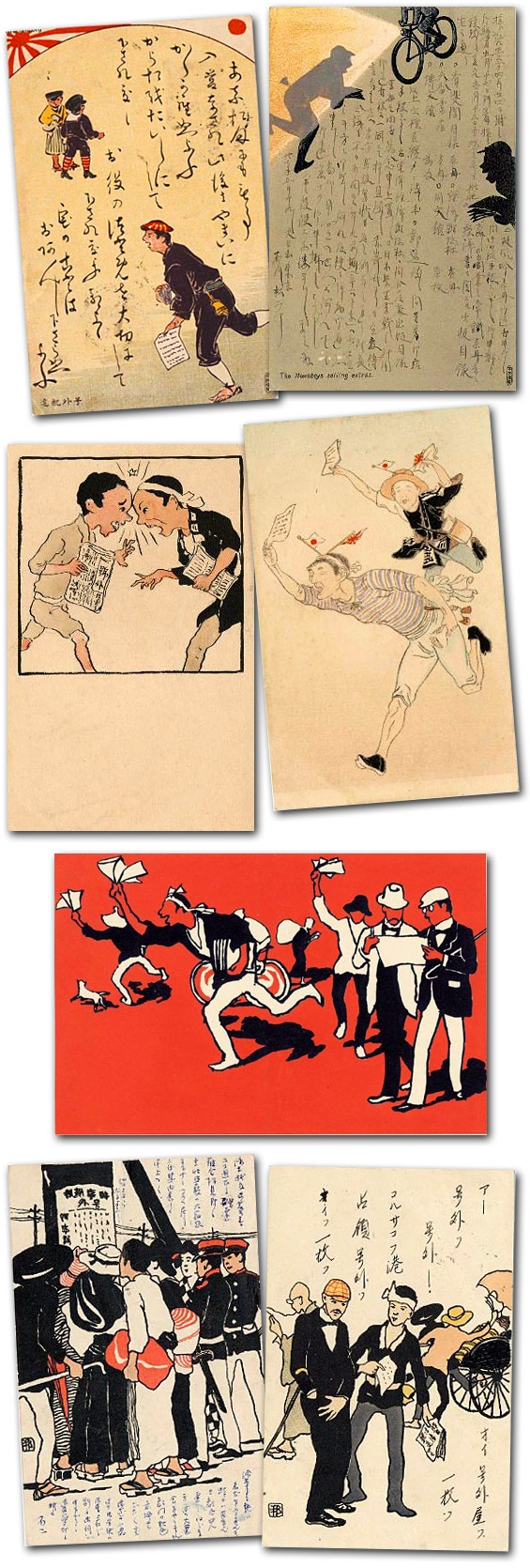| |
Celebration
“Women back home” were an integral part of the postcard boom, and artists devoted almost as much time to the home front as they did to the battlefront. Unlike the earlier war against China, where Japanese fatalities were relatively light, close to 100,000 Japanese perished in the Russo-Japanese War. The sense of ultimate sacrifice was always present, and picture postcards did not exclude the grieving widow and orphaned child from their subject matter.
|
![“Surviving Members of a Family” Artist unknown, 1904-05 [2002.3371] Leonard A. Lauder Collection, Museum of Fine Arts, Boston](image/2002_3371_s.jpg) |
  Japanese postcards did not shy away from the hardship and sacrifice the war imposed on families back home. This rendering of a war widow with her little boy incorporates a memorial service for the war dead and a scene of the Shōkonsha at Yasukuni Shrine, where the souls of those who died for the emperor were enshrined. Japanese postcards did not shy away from the hardship and sacrifice the war imposed on families back home. This rendering of a war widow with her little boy incorporates a memorial service for the war dead and a scene of the Shōkonsha at Yasukuni Shrine, where the souls of those who died for the emperor were enshrined.
“Surviving Members of a Family”
[2002.3371]
|
Most often, however, the message was one of concerned but optimistic support for the men on the front. Wives dreamed of their husbands celebrating victory in battle. They waited patiently with their children for heroic homecomings, and devoured letters sent from the front. Women sewed clothing for the military and joined in making the “thousand-stitch belly warmers” (senninbari) that symbolized an intimate relationship between brave men abroad and their communities back home. (In theory, a different girl or woman added each of the thousand decorative stitches on these stomach warmers.) Schoolgirls in their distinctive uniforms lined up to offer a ceremonial banzai for the men at the front. Fashionable Japanese women (sometimes virtually indistinguishable from high-society Caucasian ladies) saw troops off with flowers at the railway station.
|
![“Occupation of Nanshan and Dream of the Homes” Artist unknown, 1904-05 [2002.3370] Leonard A. Lauder Collection, Museum of Fine Arts, Boston](image/2002_3370_s.jpg) |
  “Occupation of Nanshan and Dream of the Homes” “Occupation of Nanshan and Dream of the Homes”
[2002.3370]
|
![“Mother and Child Giving a Soldier a Send-Off” Artist unknown, 1904-05 [2002.3371] Leonard A. Lauder Collection, Museum of Fine Arts, Boston](image/2002_3182_s.jpg)
“Mother and Child Giving a
Soldier a Send-Off”
[2002.3182]
![“Mother and Child Holding the Japanese Flag” Artist unknown, 1906 [2002.3515] Leonard A. Lauder Collection, Museum of Fine Arts, Boston](image/2002_3515_s.jpg)
“Mother and Child Holding the
Japanese Flag,” 1906
[2002.3515]
![“Letter from the Front” Artist unknown, 1904-05 [2002.6865] Leonard A. Lauder Collection, Museum of Fine Arts, Boston](image/2002_6865_s.jpg)
“Letter from the Front”
[2002.6865]
|
![“Returning Home” Artist unknown, 1904-05 [2002.5180] Leonard A. Lauder Collection, Museum of Fine Arts, Boston](image/2002_5180_s.jpg)
“Returning Home”
[2002.5180]
![“Commemoration of the Ceremony of the Army Triumphant Return” Artist unknown, 1904-05 [2002.5130] Leonard A. Lauder Collection, Museum of Fine Arts, Boston](image/2002_5130_s.jpg)
“Commemoration of the Ceremony of the Army's Triumphant Return”
[2002.5130]
![“News from the Seat of the War” Artist unknown, 1904-05 [2002.5125] Leonard A. Lauder Collection, Museum of Fine Arts, Boston](image/2002_5125_s.jpg)
“News from the Seat of the War”
[2002.5125]
|
![“Woman Sewing for a Soldier” Artist unknown, 1904-05 [2002.3181] Leonard A. Lauder Collection, Museum of Fine Arts, Boston](image/2002_3181_s5422_Copy.jpg)
“Woman Sewing for a Soldier”
[2002.3181]
![“School Girls' Banzai” Artist unknown, 1904-05 [2002.5133] Leonard A. Lauder Collection, Museum of Fine Arts, Boston](image/2002_5133_s5419_Copy.jpg)
“School Girls' Banzai”
[2002.5133]
|
![“With Whole Heart” Artist unknown, 1906 [2002.5244] Leonard A. Lauder Collection, Museum of Fine Arts, Boston](image/2002_5244_s5421_Copy.jpg)
“With Whole Heart”
[2002.5244]
![“Ujima” Artist unknown, 1904-05 [2002.5179] Leonard A. Lauder Collection, Museum of Fine Arts, Boston](image/2002_5179_s5420_Copy.jpg)
“Ujima”
[2002.5179]
|
By far the most eye-catching “war” postcards seemed, at first glance, as far removed from carnage and sacrifice as could possibly be imagined. Almost amounting to a little sub-genre, these depicted victory celebrations at home and the popular frenzy for glorious “news” from the front.
In one of the more conventional but instructive postcard depictions of domestic war coverage, a traditionally dressed young woman stands in the doorway of a news shop that displays a large rising sun flag. All kinds of war reportage surround her. Newspaper street vendors hawk a special edition (the English caption on this bilingual card reads “Extra of Victory”). Two uniformed policemen and a male pedestrian in Western dress peruse the papers, while two other men wearing straw boaters read the news posted on the shop front itself. Woodblock war prints are also on display, alongside a nice self-referential touch: numerous postcards.
|
 |
  “Latest News from Seat of War” “Latest News from Seat of War”
[2002.2406]
|
  “Extra of Victory” “Extra of Victory”
[2002.5267] |
Other illustrators found this communications boom not only appropriate as a subject, but also conducive to exceptionally energetic compositions. On one picture postcard, for instance, a newspaper vendor with tiny flags in his headband runs straight at the viewer. In another absolutely sensational rendering—done entirely in black and white against a red background—vendors hawk their papers while two stylish, anglicized gentlemen stroll into the scene engrossed in a newspaper they hold between them. (While this rendering is a fine example of the fresh eye artists brought to the scene, the lively street vendors might almost have run out of one of Hokusai’s famous mid-19th-century sketchbooks of ordinary people in every imaginable pose.)
|
![“Newspaper Man Rushing in the Latest” Artist unknown, 1904-05 [2002.1580] Leonard A. Lauder Collection, Museum of Fine Arts, Boston](image/2002_1580_s.jpg) |
Celebration of the war was often indistinguishable from celebration of Japan’s rapid Westernization and modernization—which included a great boom in mass communications. In this milieu, “news of the war” became, in and of itself, a popular subject for postcards. This emerged in depictions of traditional shops selling war prints and postcards, as well as scenes of hawking the latest news from the front. Rival newsboys butted heads, and crowds gathered around news sheets posted in public places. Some postcards not only depicted highly-Westernized “modern men” devouring the news, but also did so in a strikingly fashionable “art nouveau” style.
“Newspaper Man Rushing in the Latest”
[2002.1580]

|
 |
  “Newsboy Selling Extras” (left, with hand-written message) “Newsboy Selling Extras” (left, with hand-written message)
[2002.3335]
“The Newsboys Selling Extras” (right, with hand-written message)
[2002.5245]
“Newsboys in Fight” (left)
[2002.5242]
“Newsboys Rushing with the Latest News”
(right)
[2002.5241]
“News Runners Rushing in with the Latest”
[2002.1581]
“Crowds Gathering to Read the News”
by Hashimoto Kunisuke (left, with hand-written message)
[2002.926]
“Newsboy Selling Paper”
by Hashimoto Kunisuke (right, with hand-written message)
[2002.927]
|
![“Crowds Celebrating with Flags” Artist unknown, 1904-05 [2002.1587] Leonard A. Lauder Collection, Museum of Fine Arts, Boston](image/2002_1587_s5485_Copy.jpg) ![“Parade with Japanese Flags” Artist unknown, 1904-05 [2002.3358] Leonard A. Lauder Collection, Museum of Fine Arts, Boston](image/2002_3358_s5540_Copy.jpg) |
A favorite subject is “paper lantern” festivities, where the victory celebration spilled over into nighttime and festive lanterns were strung about and even hand-carried by participants. In one joyful rendering, men in Western suits and carrying lanterns ride bicycles to a celebration, each sporting a different style of hat. They do not really look Japanese at all. War, patriotism, celebration, and fashionable “Westernization” have all blurred into one.
|
The same exuberance pervades most depictions of victory celebrations. In many instances, seen without context or captions, these might easily pass for parties, festivals, or holidays utterly divorced from war. (Even where flags are featured, one can easily imagine some sort of national holiday or civic celebration.) Women wear up-to-date Western as well as Japanese fashions and hairstyles. Men commonly wear Western suits, and frequently even top hats.
![“Celebrating War Victory” Artist unknown, 1906 [2002.1582] Leonard A. Lauder Collection, Museum of Fine Arts, Boston](image/2002_1582_s5486_Copy.jpg) ![“People Marching Under the Commemorative Lanterns” Artist unknown, 1904-05 [2002.1377] Leonard A. Lauder Collection, Museum of Fine Arts, Boston](image/2002_1377_s5529_Copy.jpg)
|
|
![“Triumphal Lanterns” Artist unknown, 1904-05 [2002.3130] Leonard A. Lauder Collection, Museum of Fine Arts, Boston](image/2002_3130_s5528_Copy.jpg)
![“Men Bicycling with Lanterns” by Hashimoto Kunisuke, 1904-05 [2002.928] Leonard A. Lauder Collection, Museum of Fine Arts, Boston](image/2002_0928_s5532_Copy.jpg) |
  Victory celebrations on the homefront drew festive crowds from all levels (including nattily-dressed high society), and often featured paper lanterns that could be illuminated in nighttime. This too captured the fancy of postcard Victory celebrations on the homefront drew festive crowds from all levels (including nattily-dressed high society), and often featured paper lanterns that could be illuminated in nighttime. This too captured the fancy of postcard
artists and collectors.
“Crowds Celebrating with Flags” (left, with hand-written message)
[2002.1587]
“Celebrating War Victory,” 1906 (right, with hand-written message)
[2002.1582]
“Parade with Japanese Flags” (left)
[2002.3358]
“People Marching Under the Commemorative Lanterns”
(right)
[2002.1377]
“Triumphal Lanterns”
[2002.3130]
“Men Bicycling with Lanterns”
by Hashimoto Kunisuke (with hand-written message in French)
[2002.0928]
|

On viewing images of a potentially disturbing nature: click here.
Images from the Leonard A. Lauder Collection of Japanese Postcards at the Museum of Fine Arts, Boston.
Unless otherwise indicated, all are by unidentified artists and date from the 1904-1905 war years.
|
|
|
|
|

